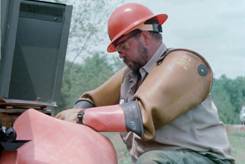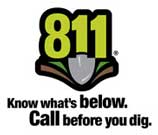
Construction | New Service
This guide, and all linked material, should be read in its entirety to help minimize problems associated with service connections. The following shortlist is a summary of the major steps suggested:
- Apply for service, and request a survey meeting with a Sumter EMC representative.
- Meet on-site with the Sumter EMC representative to discuss details of the project, especially the location of the service entrance equipment.
- Based on your meeting with the Sumter EMC representative, tell the electrician where the service entrance equipment needs to be installed.
- Notify Sumter EMC at least 2 weeks in advance to allow time for service construction.
- When construction is nearing completion, arrange an inspection (if required) with the local governmental authority.
This guide is a summary of the general requirements for membership and service. Sumter EMC's Articles of Incorporation, bylaws, service rules and regulations, rate schedules, and requirements set forth in the National Electrical Code and National Electrical Safety Code shall prevail in the event of a conflict with information provided herein.
Contact Sumter EMC Before Starting Any Construction!
Sumter EMC is a member-owned not-for-profit corporation. Our employees work hard to protect the interests of members. Sumter EMC representatives will discuss your construction plans with electricians and other contractors to help minimize costs associated with service connections. Communication between electricians and the Cooperative is vitally important to minimize expense to the member. Failure to properly plan the location of service equipment can cause costly changes in construction. The Surveys link below outlines some of the issues to be considered.
 Call Before You Dig or Work Near Overhead Lines!
Call Before You Dig or Work Near Overhead Lines!

The Georgia Utilities Protection Center (UPC) provides a single point of contact for the prevention of damage to underground utility facilities, and to protect the public and construction contractors from contact with power and gas lines. Georgia law requires that anyone digging in Georgia must contact UPC three days before construction begins. Utilities are required to locate all underground facilities in the construction area by the end of the second business day after a locate request is made. The location of utilities will be marked to prevent accidental contact.
 The Georgia UPC can be reached by calling 811, a federally mandated nationwide "Call Before You Dig" number. You may also contact UPC at the following Internet address: http://www.gaupc.com. Sumter EMC will assist members in locating underground electrical facilities if construction will take place near the marked facilities.
The Georgia UPC can be reached by calling 811, a federally mandated nationwide "Call Before You Dig" number. You may also contact UPC at the following Internet address: http://www.gaupc.com. Sumter EMC will assist members in locating underground electrical facilities if construction will take place near the marked facilities.
Georgia law further requires that anyone performing any work within 10 feet of overhead high-voltage electric power lines notify the UPC during its regular business hours at least 72 hours, excluding weekends and holidays, prior to beginning such work. Notification allows the owner or operator of the power lines to take appropriate safety measures to prevent injury to persons and property and interruptions of utility service resulting from accidental or inadvertent contact with high-voltage electric lines.
For new construction or modification to an existing service, a non-refundable contribution in aid of construction may be required. All services requiring underground service lines will be billed a minimum of $400.00. The Cooperative will extend service to certain premises at no additional charge, depending on the cost of construction, type of electrical load, and expected future revenue from the account. The member must meet with a representative of the Cooperative at the construction site to discuss the method of service and type of electrical loads to be connected. All line extensions and service wire connections, no matter who pays or contributes toward paying the cost thereof, are to be made by and remain the property of the Cooperative.
All new construction or modification to existing services requires a meeting with a Sumter EMC representative at the construction site to determine the electric service equipment required and the installation location of the equipment. The following information must be provided by the member to ensure adequate service:
- Location of buildings, water lines, gas lines (propane or natural gas), electrical wires and irrigation lines
- Electrical blueprints, including the location of the main breakers
- Type of service desired - overhead or underground
- Voltage and number of phases required (normally 120/240 volt, single-phase)
- Electrical loads to be connected, including but not limited to:
- Heating and cooling equipment information (available from the heating and air conditioning dealer)
- Air conditioner or heat pump size, in tons or BTU/hour
- Heat pump heat strip rating, in kilowatts (kW)
- Additional heating loads, such as baseboard or bathroom heating (kW)
- Major electrical appliances, including:
- Electric cooking equipment
- Electric water heater
- Electric clothes dryer, and other large electrical loads, including swimming pool or out-building
- Motor size for motors larger than 1 horsepower
- Outdoor lights to be installed by Sumter EMC - list the number and approximate location of each light
- Location of a septic tank and drain field
- Water well and pump location
- Driveway location, and present or future plans for paving or concrete
- Locations of sidewalks, swimming pool, fence lines, out-buildings, and other potential obstructions to the construction, operation, and maintenance of service equipment and wires
- Landscaping plans, including excavation and other elevation changes
Sumter EMC can help members get maximum future use of their property by assessing each site to identify the areas that must be kept accessible to cooperative personnel for construction, operation, and routine maintenance of the electric service equipment.

For equipment associated with underground construction, regular inspections and operations require ready access to equipment. If planted adjacent to pad-mounted transformers or switchgear, ornamental plants may be disturbed or destroyed by linemen who must operate and maintain the equipment. Fences, sidewalks, or other obstructions installed above underground power cables may sustain damage or have to be removed to restore power in the event of a cable failure. Such obstructions may be very expensive for the member to repair or replace, and they may also increase the time required to restore power.
Avoid planting trees or other plants that will grow within 20 feet of power lines. To ensure reliable electric service, Sumter EMC must trim and/or remove vegetation that may contact the power lines. Vegetation that has been trimmed may be less desirable than low-growing species or trees planted where power line contact will not occur.
Wired meter poles are available for purchase from Sumter EMC for installations requiring a meter pole. These wired meter poles are complete with meter socket, mast, and 200-amp main breaker (or, for irrigation pivots, 30 or 60 amp fused disconnects). On 200-amp, 240 volt models, the breaker box includes unused breaker positions suitable for connecting outdoor electrical equipment such as heat pumps and water pumps. Sumter EMC will also deliver and set the meter pole for an additional fee. Click here for a listing of available 200 Amp, 60 Amp, and 30 Amp meter and disconnect poles and pedestals, and additional installation guidelines.
A licensed electrician should install the wiring between the meter pole and the building. All permits required to receive service are the responsibility of the member.
Sumter EMC provides meter sockets to the member or the member's electrician at no charge. The electrician is responsible for installing and maintaining all equipment beyond the service point, including the meter socket (see sample drawings on page 6 to determine the location of the service point). Meter sockets should not be installed in areas where add-on rooms are planned. Wall-mounted meter sockets must be accessible on an exterior wall to ensure access for meter reading or emergency maintenance.
The appropriate meter socket-type should be determined by the member's electrician. The following common meter socket types are available for single-phase installations:
- 200 Amp, 4-Terminal for overhead service drops
- 200 Amp, 4-Terminal for underground service drops
- 400 Amp, 4-Terminal for overhead service drops
- 400 Amp, 4-Terminal for underground service drops
Meter Socket Location and Temporary Service
Before construction begins, the property owners should meet with a representative of Sumter EMC to determine the location of service equipment. The owner should then inform the electrician and other contractors of the agreed-upon location of the service equipment. The electrician must install the meter socket and entrance cables at the location agreed upon by the member and Sumter EMC. Failure to install the meter socket and entrance cables at the proper location can result in costly changes for the member. If the electrician suggests a different location, before proceeding he must contact Sumter EMC to discuss options in order to minimize additional costs to the member.
During the construction of a new building, temporary electrical service may be needed for new power tools and other uses. The member's electrician is responsible for installing a temporary meter pole. The temporary meter pole should be installed within a few feet of the permanent service connection point, or for locations where a pad-mounted transformer is installed, the temporary meter pole should be installed adjacent to the transformer.
The following three-phase voltages are readily available from Sumter EMC:
- 120/240 volt, three-phase (available only from pole-top transformers if the total three-phase load is greater than 20 kW)
- 120/208 volt, three-phase
- 277/480 volt, three-phase
- 240/480 volt, three-phase (available only from pole-top transformers if the total three-phase load is greater than 20 kW)
Other voltages may be available at special request.
Sumter EMC is required by local jurisdictions to adhere to their policies and regulations regarding connections of electrical service. Permits must be obtained before a service can be connected. The table below lists cities and counties that require permits. See the bottom of this page for an explanation of the footnotes indicated by an '*'.
| Jurisdiction | Permit type | contact # |
|---|---|---|
| Chattahoochee County/Cusseta | Building & Electrical | 706-989-3422 |
| City of Americus **** | Building & Mobile Home | 229-924-4411 |
| Dougherty **** | Electric | 229-438-3901 |
| Lee *|** | Electrical & Mobile Home | 229-759-6003 |
| Marion | Building & Electrical | 229-649-5670 |
| Randolph | Building, Mobile Home, and Electrical | 229-732-5212 |
| Schley | Building | 229-937-9169 |
| Stewart **** | Building & Electrical | 229-838-6769 |
| Sumter *|**|***|**** | Electrical & Mobile Home | 229-928-4547 |
| Terrell | Building | 229-995-5210 |
| Webster**** | Mobile Home & Building | 229-828-3690 (Building Permits Only) 229-828-5775 |
The permit types listed above are required before the meter is set for permanent service.
| Footnote Symbol | Special Conditions |
|---|---|
| * | Any mobile home moved onto an existing lot requires a permit before the meter is set |
| ** | For any electrical work where replacement of equipment or parts is performed, a permit is required before service can be hooked back up |
| *** | Temporary services require a permit before the meter is set |
| **** | All mobile homes, and new or existing rental units, require a permit before the meter is set |
